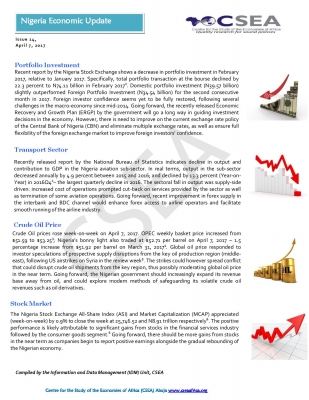Macroeconomic Report & Economic Updates

April 4, 2017
Nigeria Economic Update (Issue 14)
Recently released report by the National Bureau of Statistics indicates decline in output and contribution to GDP in the Nigeria aviation sub-sector. In real terms, output in the sub-sector decreased annually by 4.9 percent between 2015 and 2016; and declined by 13.3 percent (Year-on-Year) in 2016Q4 the largest quarterly decline in 2016. The sectoral fall in output was supply-side driven: increased cost of operations prompted cut-back on services provided by the sector as well as termination of some aviation operations. Going forward, recent improvement in forex supply in the interbank and BDC channel would enhance forex access to airline operators and facilitate smooth running of the airline industry.
